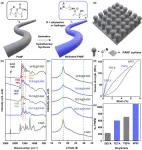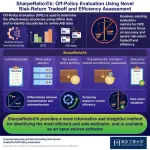(Press-News.org) ROCKVILLE, Md.— Compared to their civilian counterparts, excessive pregnancy weight gain is more frequent among military health care beneficiaries, in particular active duty personnel, and is associated with costly maternal/neonatal complications. Women in this sample with excessive pregnancy weight gain were also three times more likely to have substantial postpartum weight retention, according to a new study published in the journal Obesity, The Obesity Society’s (TOS) flagship journal.
Substantial weight retention at 12 months postpartum was also more common among military health care beneficiaries in this sample than previously documented in civilian samples. Postpartum weight retention is a key concern for the United States military because it impacts active duty women’s ability to pass their fitness tests and is also associated with long-term maternal overweight and obesity.
“These results emphasize the importance of weight management before, during and after pregnancy for military populations, given the high health care costs of weight-related health complications affecting the mother and baby as well as the importance of maintaining fitness in the active duty population,” said Rebecca Krukowski, PhD, professor, Department of Public Health Sciences, School of Medicine, University of Virginia, Charlottesville, Va. Krukowski is the corresponding author of the study.
Data for military health care beneficiaries were obtained from the Military Health System Data Repository. More than 48,000 women who had given birth in 2018 and 2019 were included. Researchers examined relationships among overweight and obesity, pregnancy weight gain, maternal and neonatal complications and substantial postpartum weight retention.
Pregnancy weight gain was determined by the amount of weight gained between a measured pre-pregnancy weight to a delivery weight. The amount of pregnancy weight gain was then compared to the national guidelines for pregnancy weight gain from the National Academy of Medicine. For body mass index, women were classified into four categories: underweight, healthy, overweight, and obesity based on the pre-pregnancy weight and height. Substantial postpartum weight retention was defined as retention of at least 10 pounds at 12-months postpartum compared with pre-conception weight. Clinical outcomes potentially related to pregnancy weight gain and body mass index were abstracted from the maternal and neonatal health care records. For maternal clinical outcomes, cases of preeclampsia, pregnancy-induced hypertension, gestational diabetes and caesarean delivery were identified. For neonatal outcomes, researchers identified infants who experienced intrauterine growth restriction, were small or large for gestational age, had low birth weight and had a neonatal intensive care unit admission.
Results showed that 75% of TRICARE beneficiaries had excessive pregnancy weight gain. Military spouses and other family members were less likely than active duty women to have excessive pregnancy weight gain. Those with excessive pregnancy weight gain and/or overweight or obesity were more likely to have maternal complications such as pregnancy-induced hypertension and cesarean delivery. The findings also showed that 42% of the military beneficiaries had substantial postpartum weight retention. Additionally, women with excessive pregnancy weight gain were three times more likely to have substantial postpartum weight retention. Researchers add that pregnancy-related weight gain above the national guidelines and substantial postpartum weight retention may make it challenging to regain the required fitness levels for active duty women and for these women (who want to serve their country) to maintain their career in the military.
Other authors of the study include Wen You and Carol Copeland, Department of Public Health Sciences, School of Medicine, University of Virginia, Charlottesville, Va. Copeland is also with the 59th Medical Wing, Clinical Health Psychology, Joint Base San Antonio, Texas. Erin Solomon, Department of Psychology, University of Memphis, Memphis, Tenn.; Juan Lang, Department of Biostatistics, College of Public Health, University of Kentucky, Lexington, Ky.; Emily Stone, Geneva Foundation, Bethesda, Md.; Rosemary Estevez Burns, 59th Medical Wing, Clinical Health Psychology, Joint Base San Antonio, Texas; Zoran Bursac, Department of Biostatistics, Florida International University, Miami, Fla.; Marion E. Hare, Department of Preventative Medicine, University of Tennessee Health Science Center, Memphis, Tenn.; and Teresa M. Waters, Augusta University, Institute for Public and Preventative Health, Augusta, Ga.
The authors declared no conflicts of interest.
The study, titled “Overweight/Obesity, Gestational Weight Gain, Postpartum Weight Retention and Maternal/Neonatal Complications in the Military” will be published in the May 2024 issue of Obesity.
# # #
The Obesity Society (TOS) is the leading organization of scientists and health professionals devoted to understanding and reversing the epidemic of obesity and its adverse health, economic and societal effects. Combining the perspective of researchers, clinicians, policymakers and patients, TOS promotes innovative research, education and evidence-based clinical care to improve the health and well-being of all people with obesity. For more information, visit www.obesity.org.
END
Body odor from the armpits comes from bacteria metabolizing sweat produced by the apocrine glands. These bacteria are native to our skin, but the odors produced differ among people. Generally, people use deodorants on their armpits, but perhaps there is a way to get rid of the bacteria.
To find out, a research team led by Osaka Metropolitan University Professor Satoshi Uematsu and Associate Professor Kosuke Fujimoto at the Graduate School of Medicine collected body fluid samples from the armpits of 20 men that were deemed healthy. In advance, a subjective olfactory panel classified ...
When it comes to matters of the heart, cardiovascular disease in women is underdiagnosed compared to men. A popular scoring system used to estimate how likely a person is to develop a cardiovascular disease within the next 10 years is the Framingham Risk Score. It is based on factors including age, sex, cholesterol levels, and blood pressure.
Researchers in the US and the Netherlands have now used a large dataset to build more accurate cardiovascular risk models than the Framingham Risk Score. They also quantified the underdiagnosis of women compared to men. The results were published in Frontiers ...
Korea relies on imports for most of its metal resources, and in recent years, due to resource depletion and rising raw material prices, 'circular resources' that recycle waste metal resources have emerged. In response, SK hynix has established a mid- to long-term plan to increase the percentage of copper, gold, etc. recovered and reused from waste generated in the semiconductor manufacturing process to more than 30% by 2030, and Samsung Electronics is running a collection program for used mobile phones in cooperation with E-circulation Governance, a non-profit corporation. The global circular economy market is expected ...
A University of Adelaide study of shallow-water fish communities on rocky reefs in south-eastern Australia has found climate change is helping tropical fish species invade temperate Australian waters.
“The fish are travelling into these Australian ecosystems as larvae caught in the Eastern Australian Current, which is strengthening due to the warming climate,” said the University of Adelaide’s Professor Ivan Nagelkerken, Chief Investigator of the study.
“These larvae would not normally survive in the cooler Australian ...
A Curtin University study has revealed breeding less-flatulent cows and restoring agricultural land could significantly reduce rising methane emission levels, which play a considerable role in climate change.
The food system, including grazing animals such as cows, generates major sources of methane mainly due to cattle digestion, manure decomposition and land use for grazing.
To look for solutions, researchers from the Curtin University Sustainability Policy Institute analysed 27 academic publications and identified dozens of potential strategies to reduce methane emissions from Australia’s beef and dairy sectors.
Study ...
Lateropulsion, a clinical condition which results in the body leaning to one side, affects about half of all stroke survivors.
Edith Cowan University (ECU) PhD graduate Dr Jessica Nolan said while the problem is common, lateropulsion is still severely under recognised and under assessed around the world.
“A person with lateropulsion uses the limbs on their stronger side, to push themselves over toward their weaker side. Often those with lateropulsion resist correction back towards their stronger ...
Reinforcement learning (RL) is a machine learning technique that trains software by mimicking the trial-and-error learning process of humans. It has demonstrated considerable success in many areas that involve sequential decision-making. However, training RL models with real-world online tests is often undesirable as it can be risky, time-consuming and, importantly, unethical. Thus, using offline datasets that are naturally collected through past operations is becoming increasingly popular for training and evaluating RL and bandit ...
Researchers at the University of Arizona College of Medicine – Tucson were awarded a $1.8 million grant by the National Institute of General Medical Sciences, a division of the National Institutes of Health, to learn how human papillomavirus makes its way to a cell’s nucleus.
Human papillomavirus, or HPV, which can cause warts and certain cancers, has been with us since the dawn of humanity and causes about 5% of cancers worldwide. It also is an important source of information about human biology, according to Samuel K. Campos, PhD, an associate professor of immunobiology at the University of Arizona College of Medicine ...
A new study has found there are no adverse long-term cardiovascular health consequences for the now-adult children of mothers who were given corticosteroids because they were at risk of early birth in a landmark trial conducted in Auckland, New Zealand, 50 years ago.
The Auckland Steroid Study by obstetrician Professor Graham ‘Mont’ Liggins and paediatrician colleague Dr Ross Howie from 1969 to 1974 in Green Lane Hospital, Auckland, found that two corticosteroid injections given to pregnant women at risk of early (preterm) birth halved the incidence of respiratory distress in the babies and significantly reduced neonatal deaths.
Co-author of the new study, Dr ...
Active military service may heighten a woman’s risk of having a low birthweight baby, suggests a review of the available scientific evidence published online in the journal BMJ Military Health.
The findings highlight the need for more research specifically focused on women in the armed forces, and their reproductive health in particular, conclude the study authors.
Worldwide, increasing numbers of women are on active service in their country’s armed forces. The UK Armed Forces, for example, has set a target of 30% female representation by 2030. And more and more countries are deploying women in combat ...




